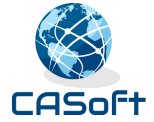Team Foundation Server (TFS) is a Microsoft offering for source control, data collection, reporting, and project tracking, and is intended for collaborative software development projects.
It is not just a bug tracking tool.
It is available either as stand-alone software, or as the server side back end platform for Visual Studio Team System (VSTS).
TFS Architecture:

When creating a project, there are 2 project templates to choose from:
- MSF Agile:
- Provide Work items and Processes that support Agile programming approach
- MSF CMMI
- Based on MSF Agile, it stretches the Agile approach to comply with CMMI Maturity level 3.
- It is 150% larger than MSF Agile, for example MSF Agile has 25 work product artefacts, MSF CMMI has 59.
TFS manages pretty much everything as Work Items:
 The recommended links organisation is as follows:
The recommended links organisation is as follows:
 Queries and reports can be developed in order to retreive any data from TFS. There are existing reports, such as Bugs rate and Remaining work.SharePoint Web Access allows web access to all the information in TFS: Work items, Queires, Reports, Documents, Source Control, Builds and also Timesheets. SharePoint can be used by project Stakeholders, including the Customer if you wish.
Queries and reports can be developed in order to retreive any data from TFS. There are existing reports, such as Bugs rate and Remaining work.SharePoint Web Access allows web access to all the information in TFS: Work items, Queires, Reports, Documents, Source Control, Builds and also Timesheets. SharePoint can be used by project Stakeholders, including the Customer if you wish.
SharePoint Project Portal provides documents repositories for projects and Wiki features.
The Integration of TFS and Excel allows to extract any data from TFS into Excel, using queries. The data is copied in the spreadsheet and can be refreshed from TFS at the press of a button. The data can also be edited in Excel and be published in TFS. Charts can then be developed in Excel.
It is also possible to develop pivot-table that access the TFS database directly (instead of running a TFS query).
There are also plug-ins to TFS, such as:
- Calibre VSTS Add-in, which allows synchronisation of requirements with the tool from Borland
- Test Director Synchronisation Engine, which allows synchronisation of bugs with the Quality Centre.
Also TFS Power Tools, to be downloaded, offer very interesting features, such as:
- Process Template Editor
- Work Item Editor
- Custom check-in policies
- TFS Server Manager
- TFS Client Tool
- Alert Editor
Finally TFS 2010 will offer the following additional features:
- Architecture Explorer, which is a graphical visualisation of code
- 7 diagrams UML supported, for design and share diagrams
- Tools for test cases management, such as tooling for better documentation & test
- Test Impact View, which allows to run tests impacted by a code change only
- Enhanced Vision Control, with gated check-in, branch visualisation & build workflow
 CASoft Blog
CASoft Blog









